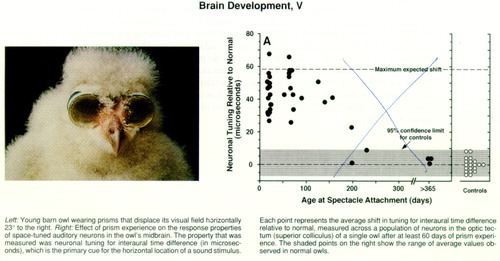Brain Development, V: Experience Affects Brain Development
Many animal and human behaviors are shaped profoundly by experience during early life. The barn owl has been productively studied as a model of the manner in which altered early experience influences behavior. The altered experience in this model is produced by an external optical lens (prismatic spectacles); the way the brain localizes sounds in space, which is necessary in the owl for feeding, is the target behavior. When an owl is raised wearing prismatic spectacles that change the apparent locations of sounds along the horizon (left figure), the owl learns to adjust its auditory orienting response according to the displacement of the visual field, so that it correctly sees the source of the sound through the prisms. This adjustment is mediated by a change in the response properties of neurons in the central auditory pathway as well as an anatomical change in this pathway. The ability of visual experience, with spectacles, to alter sound localization behavior in the owl is developmentally regulated. The period during which the owl brain can adjust adaptively to prismatic displacement of the visual field ends at 70–200 days of age, depending on the animal's environment. On the other hand, the age at which spectacle-reared owls can return to normal after removal of spectacles is from 200 days to a full lifetime (again, depending on environment). The factor that most powerfully influences either the ability of the normal owl to adapt to spectacles or the ability of the older (mature) owl to regain normal sound localization after removal of spectacles is environmental richness. Caged owls that cannot fly are the most age-restricted in using new visual experience to modify auditory processing. Owls raised in an aviary where free flight is possible display more plasticity (i.e., adaptiveness) in altering the tuning of space-tuned auditory neurons in response to visual experience. Young owls in the aviary exhibit the longest period—up to 200 days—during which this plasticity is possible (right figure). Older owls reared with spectacles in the aviary can recover fully normal neuronal response properties after spectacle removal at any age. The neural mechanisms that underlie the developmental limit to visually induced changes in sound localization behavior and auditory neuron response properties are being studied. The reason that spectacle-reared owls are able to recover normal auditory localization with prism removal at any age may be that the pathways for normal sound localization are closely approximated in normal owls at birth and are therefore already “laid down.” The data derived from this model system may be used to extend our understanding of the neural basis of other, more complex developmentally influenced behaviors in owls and in humans.
Address reprint requests to Dr. Tamminga, Maryland Psychiatric Research Center, P.O. Box 21247, Baltimore, MD 21228. Figures are courtesy of Dr. Knudsen.

FIGURE 1. Left: Young barn owl wearing prisms that displace its visual field horizontally 23° to the right. Right: Effect of prism experience on the response properties of space-tuned auditory neurons in the owl's midbrain. The property that was measured was neuronal tuning for interaural time difference (in microseconds), which is the primary cue for the horizontal location of a sound stimulus. Each point represents the average shift in tuning for interaural time difference relative to normal, measured across a population of neurons in the optic tectum (superior colliculus) of a single owl after at least 60 days of prism experience. The shaded points on the right show the range of average values observed in normal owls.



